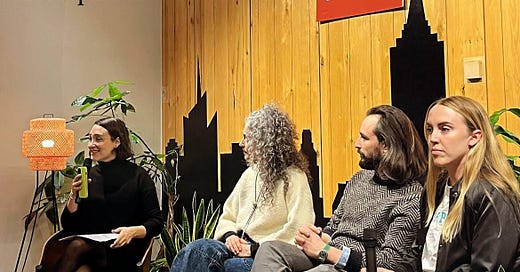Last week, FABSCRAP dove deep into The Microplastic Paradox: Navigating Sustainable Textiles
This eye-opening panel explored the rapidly evolving challenges and solutions to plastic in and from our textiles! Understanding the microplastic paradox is just the beginning of the journey toward a better textile future!
You can watch the panel here, but below are key takeaways, resources, and what you can do as a consumer.
But the conversation doesn’t stop there! We have two exciting events coming up:
🧶 Knitting Workshop | March 3rd @ FABSCRAP– Get hands-on with sustainable fibers and learn how to craft with intention. Beginner friendly & materials provided.
📖 Chat with Alden Wicker, Author of To Dye For | March 19th @ LIU Brooklyn & virtual – Join us for a discussion on the toxic truths of fashion and how to make safer, more sustainable choices. DISCOUNT CODE TO BUY THE BOOK IN TICKET INK
Firstly, let’s meet our panelists!
This panel was strategically put together to “follow the fabric.” This is something we say at FABSCRAP all the time. Just like many consumers are trying to get a better understanding of where their food is coming from, the panelist helped us understand where our clothes are coming from.
Starting with fiber:
Laura Sansone is the founder of New York Textile Lab & Carbon Farm Network. Her goal is to localize fiber and fabric production.
She mentioned a few times during the panel, “Bio-region Production” which is creating within the natural limits and resources of a specific geographic area.
Instead of relying on political or economic boundaries, it focuses on the land’s natural characteristics—like climate, soil, and available materials. This approach ensures that production stays sustainable by working with local resources and manufacturers rather than exceeding what the region can naturally support.
Moving to microplastic shedding:
Yoni Ronn is the founder of Moby Filters. His goal is to manage microplastics via capture and reuse.
Previously, he was a research program manager at Columbia University and he reminded the group that while microplastics are harmful, it’s important to remember that plastic has made positive contributions to humanity as well.
Lastly, understanding what brands can do:
Mary Bemis is the Founder of Reprise Activewear. Her goal is to eliminate plastic from our clothes.
Reprise is a plant-based and non-toxic consumer brand. And their main material is Tencel. We use a proprietary Tencel fabric that's really soft and breathable, attempting to combat the widespread use of polyester and nylon in over 90% of activewear.
Tencel is the brand name for a fabric made from wood (eucalyptus) pulp. Reprise has a proprietary blend.
Key Takeaways
Textile Waste is a Hidden Crisis
Nearly half of all fabric produced (47%) is wasted before it even reaches consumers—an alarming statistic that underscores the need for systemic change.
Keep reading with a 7-day free trial
Subscribe to Better Together Substack to keep reading this post and get 7 days of free access to the full post archives.





